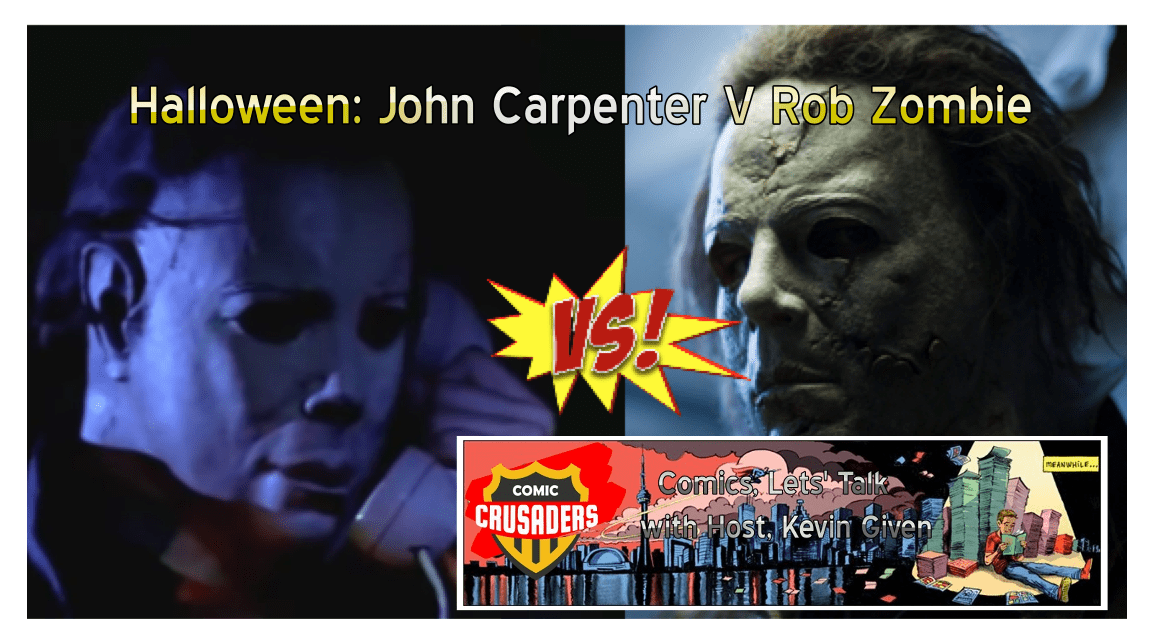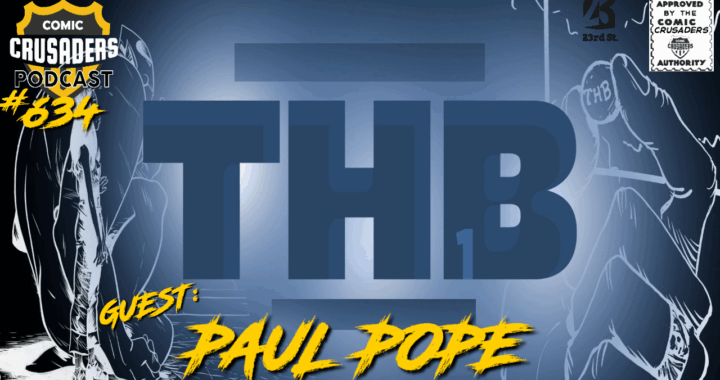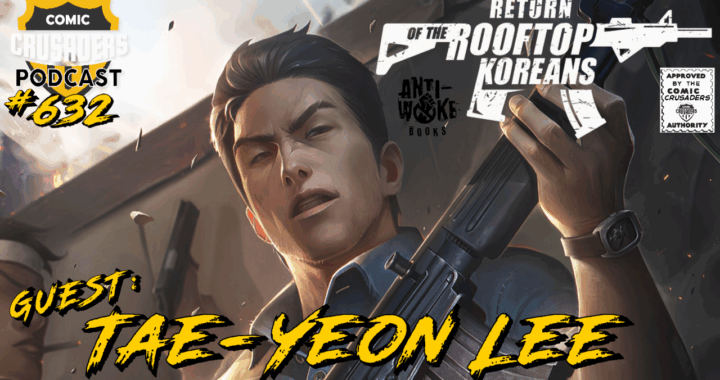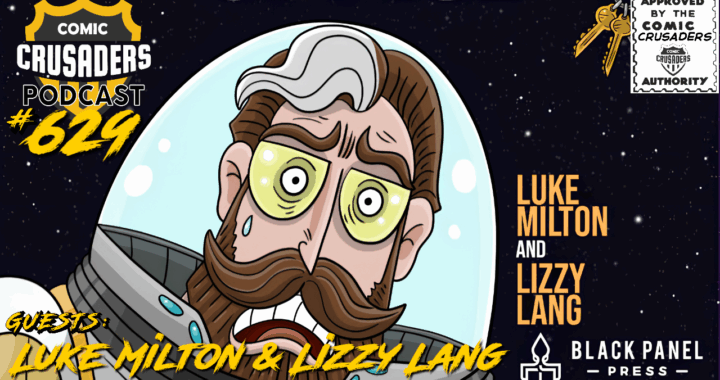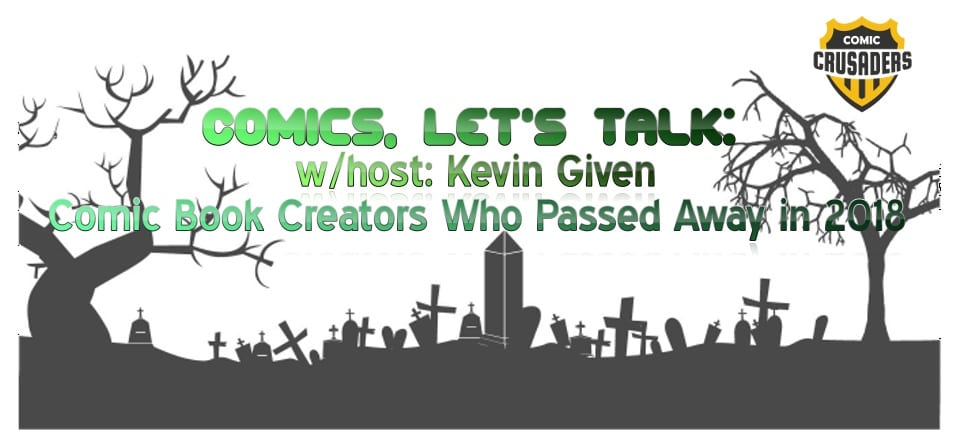
Comics, Let’s Talk: Comic Book Creators Who Passed Away in 2018
Our resident Comic Book Historian, Mr. Kevin Given, goes over the huge losses in 2018 of many beloved creators:
Mark Campos
Although he remained on the fringes of comics publishing, appearing almost exclusively in the small press, Mark Campos was a crucial figure in the Seattle comics scene. From the mid1980s, he participated in various groups which included many notable comics creators, including Jim Woodring, Lynda Barry, Peter Bagge, Jason Lutes, Tom Hart, Ellen Forney, David Lasky, and Megan Kelso. As Campos himself once put it, he was a part of the Seattle wing of the alternative comix movement.”“ Cartoonist Steve Willis has written, “In all my years of meeting comix artists there are two people who I consider to be master writers in the medium: Matt Groening and Mark Campos.”“ His comics appeared in magazines like Hyena, Gay Comix, Itchy Planet, and Naughty Bits, as well as several Seattle newspapers. He also worked for a comic publisher called Cartoon Loonacy. Before his death, Campos was working on an autobiographical project called “Casino Son”“
Mort Walker
Addison Morton Walker (September 3, 1923 ”“ January 27, 2018) was an American comic strip writer, best known for creating the newspaper comic strips Beetle Bailey in 1950 and Hi and Lois in 1954. He signed Addison to some of his strips. After graduation, Walker went to New York to pursue a career in cartooning. He began doing Spider, a one-panel series for The Saturday Evening Post, about a lazy, laid-back college student.[17] When he decided he could make more money doing a multi-panel comic strip Spider morphed into Beetle Bailey, eventually distributed by King Features Syndicate to 1,800 newspapers in more than 50 countries for a combined readership of 200 million daily.[18] In 1954, Walker and Dik Browne teamed to launch Hi and Lois, a spin-off of Beetle Bailey (Lois was Beetle’s sister). Under the pseudonym “Addison”, Walker began Boner’s Ark in 1968. Other comic strips created by Walker include Gamin and Patches, Mrs. Fitz’s Flats, The Evermores (with Johnny Sajem), Sam’s Strip, and Sam and Silo (the last two with Jerry Dumas). In 1974, Walker opened the Museum of Cartoon Art, the first museum devoted to the art of comics. It was initially located in Greenwich, Connecticut, and Rye Brook, New York, before moving to Boca Raton, Florida, in 1992
Murray Karn
Murray Karn is a significant presence in Canadian comic book history, though his career in this field only lasted a few short years. Inspired by the artwork of Alex Raymond and Hal Foster, popular cartoonists who created the Flash Gordon and Hal Foster adventure comics, Karn entered the Canadian comic field at the age of 18 by answering a call for artists in the local paper. At this time, the Canadian comic industry was brand new, created through a war-time ban on American ”˜non-essential imports“ which included the popular comic book. Bell Features was the largest of these companies, running dozens of titles and selling millions of issues to children across Canada, though when Karn joined they were a fledgling firm with few titles released. The two characters that Karn is best known for are Thunderfist and Jeff Waring, which ran as features in at least two of Bell Features“ monthly comic titles. Thunderfist was Karn“s first work, this feature focused on a technologically-enhanced superhero who fought against the Axis powers. Having proven himself as a capable artist on Thunderfist, Karn was granted the opportunity to create his own feature, which he did in the form of Jeff Waring, the dashing Amazonian adventurer.
Lee Holley
Lee Holley, who assisted on Dennis the Menace and subsequently created an idyllic picture of postwar American teenage life through his Ponytail syndicated daily cartoon panel, died on March 26 in a plane crash in Marina, California. He was 85. Holley, an amateur pilot, was flying his single-engine plane when it crashed at Marina“s municipal airport on the morning of the 26th, reported Matthew Sedacca at The New York Times. There were no passengers aboard. Marina is about ten miles north of Monterey, where Holley lived.
Fred Boatman
Fred Boatman was an American cartoonist and graphic artist, who regularly contributed to hot-rod humor magazines like CARtoons by Petersen Publishing in the 1960s and 1970s. Frederick Carl Boatman was born in 1935 in Cleveland, Ohio. He graduated from Ohio University in Athens in 1960, and spent most of his life in Parma, Ohio. Although the was mainly active as a graphic designer, Boatman had a long stint as a cartoonist for the automotive humor magazines published by Petersen Publishing in California. Between 1962 and 1976, he made comics strips about skateboards, hot-rods, go-karts, grand-prix karts and other automotive subjects for magazines like HOT ROD CARtoons, CARtoons, SURFtoons, CYCLEtoons and CAR CRAFT and ROD & CUSTOM. Among his recurring characters were Granny McGo, Dipstick and Arin Gee.
Gunnar Persson
Gunnar Persson was a Swedish comics artist, and a longtime contributor to the comics magazine 91:an. He is best-known for taking over his father’s iconic comics series ‘Kronblom’ (1967-2010), but he has also worked on other comics like ‘Gus’, ‘Herr Larsson’, ‘Flygsoldat 113 Bom’ and ’91:an’. He came from a true dynasty of comics authors. Besides his father, Elov Persson, his brother Ingvar Persson also worked in the industry, while his son Jonas Persson, nephew Lasse Persson and niece Bia Melin also stepped in their fathers’ footsteps.
Persson furthermore served as a scriptwriter for 91:an’s funny air force strip ‘Flygsoldat 113 Bom’, after the departure of its creator Torsten Bjarre in 1971. New artists for the comic were Lasse Persson, Bertil Wilhelmsson and Anders Persson. Gunnar Persson also wrote the scripts for the humorous comic about police officer ‘Konstapel Knut’ (1971), which was drawn by Leif Rosenqvist for Kul med Ã…sa-Nisse. Between 1982 and 1987 he was one of the scriptwriters for the Nils Egerbrandt creation ‘Frisk och Rask’ in 91:an, at the time drawn by Bertil Wilhelmsson. During the 1990s Persson dropped most of his work for Egerbrandt and concentrated fully on ‘Kronblom’. His son Jonas Persson joined his father in the production of the strip in 2006, and took over completely in 2010.
Gunnar Persson had lived in the Swedish city Örebro since 1964. He passed away on Sunday 8 April 2018 as a result of injuries sustained from a fall a couple of weeks earlier. He was 84 years old.
William Vance
William van Cutsem (8 September 1935 ”“ 14 May 2018), better known by his pen name William Vance, was a Belgian comics artist known for his distinctive realistic style and work in Franco-Belgian comics. William van Cutsem was born in Anderlecht near Brussels in 1935. After his military service in 1955”“1956, he studied for four years at the Académie Royale des Beaux-Arts in Brussels. Originally from Flanders, he worked most of his life in France, and moved later to Santander, Spain.
William Vance started drawing for the Franco-Belgian comics magazine Tintin in 1962. After drawing complete real-life stories of four pages for a few years, he started work on his first series, Howard Flynn, written by Yves Duval. Three albums followed, before he created other short-lived series such as the Western Ringo and Roderik. His first success followed with the series about secret agent Bruno Brazil, written by Tintin’s editor-in-chief Greg, as one of the comics that started the revival and repositioning of Tintin as a more adult-oriented magazine. From 1967 on, he continued the stories of Bob Morane in Femmes d’aujourd’hui, a magazine aimed at adult women. This science fiction series, based on the novels by Henri Vernes, was started by Dino Attanasio and continued by Gerald Forton before Vance took over and made it a success. Between 1969 and 1979, 18 albums with his artwork were published. A few years later, the series
moved to Tintin as well, and Vance was succeeded by his brotherin-law, Felicisimo Coria.
Vance meanwhile started two new series, Ramiro, with stories set in medieval Spain, and from 1976 onwards, Bruce J. Hawker, his personal favourite, starring a lieutenant in the Royal Navy. His final breakthrough and largest commercial success came in 1984, when writer Jean Van Hamme proposed a new series, XIII. First serialised in Spirou magazine, this series of contemporary adventures with action, violence, and complicated intrigues, let Vance draw upon his talent for realistic drawings, action scenes and exotic settings. By 2007, he had drawn 18 albums in the series, which sold more than 14 million copies in more than 20 countries and was twice adapted into a TV series. The series was coloured by his wife Petra Coria, with whom he lived in Santander, Spain. In 2010, Vance announced his retirement due to Parkinson’s disease. He died of the disease on 14 May 2018.
Harlan Ellison
Harlan Jay Ellison (May 27, 1934 ”“ June 28, 2018) was an American writer, known for his prolific and influential work in New Wave speculative fiction, and for his outspoken, combative personality. Robert Bloch, the author of Psycho, described Ellison as “the only living organism I know whose natural habitat is hot water”.
His published works include more than 1,700 short stories, novellas, screenplays, comic book scripts, teleplays, essays, and a wide range of criticism covering literature, film, television, and print media. Some of his best-known work includes the Star Trek episode “The City on the Edge of Forever”, his A Boy and His Dog cycle, and his short stories “I Have No Mouth, and I Must Scream” and ” ‘Repent, Harlequin!’ Said the Ticktockman”. He was also editor and anthologist for Dangerous Visions (1967) and Again, Dangerous Visions (1972). Ellison won numerous awards, including multiple Hugos, Nebulas, and Edgars.
Bong Dazo
Angelo ‘Bong’ Dazo passed away after a long bout with liver cancer, as confirmed by agent David Campiti and Marvel Entertainment. “Marvel is deeply saddened by the loss of Ty ‘Bong’ Dazo, artist of Deadpool and more great comics,” the publisher tweeted. “Our heartfelt condolences go out to his family, friends and fans around the world.”
Dazo is best known for his work on various Deadpool series for Marvel, as well as Dark Horse’s Star Wars: Knights of the Old Republic. His most recent work was illustrating covers for Zenescope Entertainment’s Belle: Beast Hunter.
Fred Peters
Fred Peters (January 22, 1923 [1] ”“ May 18, 2018 was an American animator and comics artist who contributed to several EC Comics. He was a carryover artist from EC’s Pre-Trend line into early issues of EC’s New Trend titles and helped make many good comics and people at his work said that he was a brilliant drawer and he often made masterpieces of art. Peters started his career at the Walt Disney Studios in the mid-1940s, where he mostly animated numerous Pluto cartoons. In 1949, he became a freelance illustrator and comics artist. Work by Peters was published in EC Comics’s Crime Patrol, Crime SuspenStories, Gunfighter, Saddle Justice, Tales from the Crypt and War Against Crime. For Crime SuspenStories, he did several EC Quickies. Fred Peters died on May 18, 2018, at the age of 95.
Julio Ribera
Julio Ribera was a Spanish comics artist, who has spent most of his career working for the French market. While his early work was published in Spanish magazines like Nicolás, El Coyote,Florita and Yumbo, Ribera has worked on a great many French comics magazines from 1954 until the 1990s. He has also drawn many newspaper comics for Opéra Mundi and France-Soir. The artist is however best known for his many collaborations with scriptwriter Christian Godard, with whom he most notably created the sci-fi saga ‘Le Vagabond des Limbes’ (1975-2003), but also the erotic ‘Le Grand Manque’ (1988-1993) and the crime noir ‘Le Grand Scandale’ (1994-1997). On his own, Ribera has made the erotic horror parody ‘Dracurella’ (1973-1979) and his autobiographical series ‘Montserrat’ (2003-2006). He worked in both a realistic and a caricatural drawing style, but he used a mix for his most popular works. In the final stages of his career, Julio Ribera published three autobiographical comic books about his early years under Franco’s fascist regime. They were published in the Grand Angle collection of the publishing house Bamboo. The first book, ‘Montserrat – Souvenirs de la guerre civile’ (2003), dealt with the Civil War and his late sister Montserrat. ‘Jeunesse bafouée – Une dictature au fil des jours’ (2005) chronicles the first years of Ribera’s artistic career, and the third book, ‘Paris Liberté – Le parfum de l’espoir’ (2006) is about his move to France. A single volume compilation was released under the title ‘Mon crayon et moi’ in 2011.
Between 2009 and 2014 Éditions Regards published ‘Capitaine Temête’, ‘Viva Maria’ and ‘Les Vagabonds’, book publications of Ribera’s early newspaper strips. The artist passed away in Cognin, France, on 27 May 2018. He was 91 years old.
Steve Ditko
Stephen John Ditko(/ˈdɪtkoÊŠ/; November 2, 1927 ”“ c. June 29, 2018) was an American comics artist and writer best known as the artist and co-creator, with Stan Lee, of the Marvel Comics superheroes Spider-Man and Doctor Strange. Ditko studied under Batman artist Jerry Robinson at the Cartoonist and Illustrators School in New York City. He began his professional career in 1953, working in the studio of Joe Simon and Jack Kirby, beginning as an inker and coming under the influence of artist Mort Meskin. During this time, he then began his long association with Charlton Comics, where he did work in the genres of science fiction, horror, and mystery. He also cocreated the superhero Captain Atom in 1960.
During the 1950s, Ditko also drew for Atlas Comics, a forerunner of Marvel Comics. He went on to contribute much significant work to Marvel. In 1966, after being the exclusive artist on The Amazing Spider-Man and the “Doctor Strange” feature in Strange Tales, Ditko left Marvel for reasons he never specified. Ditko continued to work for Charlton and also DC Comics, including a revamp of the long-running character the Blue Beetle, and creating or co-creating the Question, the Creeper, Shade the Changing Man, and Hawk and Dove. Ditko also began contributing to small independent publishers, where he created Mr. A, a hero reflecting the influence of Ayn Rand’s philosophy of Objectivism. Ditko largely declined to give interviews, saying he preferred to communicate through his work. Ditko was inducted into the comics industry’s Jack Kirby Hall of Fame in 1990, and into the Will Eisner Award Hall of Fame in 1994.
Stan Lee
Stan Lee[1] (born Stanley Martin Lieber /ˈliËbÉ™r/; December 28, 1922 ”“ November 12, 2018) was an American comic book writer, editor, and publisher who was active from the 1940s to the 2010s. He rose through the ranks of a family-run business to become Marvel Comics’ primary creative leader for two decades, leading its expansion from a small division of a publishing house to a multimedia corporation that dominated the comics industry. In collaboration with others at Marvel””particularly cowriter/artists Jack Kirby and Steve Ditko””he co-created numerous popular fictional characters, including superheroes Spider-Man, the X-Men, Iron Man, Thor, the Hulk, the Fantastic Four, Black Panther, Daredevil, Doctor Strange, Scarlet Witch and Ant-Man. In doing so, he pioneered a more naturalistic approach to writing superhero comics in the 1960s, and in the 1970s he challenged the restrictions of the Comics Code Authority, indirectly leading to changes in its policies. In the 1980s he pursued development of Marvel properties in other media, with mixed results. Following his retirement from Marvel in the 1990s, he remained a public figurehead for the company, and frequently made cameo appearances in films based on Marvel characters, on which he received an honorary “executive producer” credit. Meanwhile, he continued independent creative ventures into his 90s, until his death in 2018.
Lee was inducted into the comic book industry’s Will Eisner Award Hall of Fame in 1994 and the Jack Kirby Hall of Fame in 1995. He received the NEA’s National Medal of Arts in 2008.
Jeff Hook
Geoffrey Raynor Hook OAM (27 December 1928[1] ”“ 20 July 2018[2]), better known as Jeff Hook, was an Australian artist and editorial cartoonist. Hook was married to Pauline since 1961 and had five children. After attending St Virgil’s College, Hobart, Hook started as a cadet press artist on the Hobart Mercury and completed a course in graphic arts at the Hobart Technical College (now Tasmanian School of Art, a faculty of the University of Tasmania) which included tuition in fine arts under Jack Carington Smith, Margaret Chandler, Harry Buckey and Edith Holmes. He started his career as a press artist and part-time cartoonist on The Mercury, drawing under the name “Jeff”. He moved to Melbourne and started at The Sun News-Pictorial in 1964. Hook became the full-time cartoonist for The Sun News-Pictorial (later to be merged with the afternoon newspaper The Herald to become the Herald Sun) soon after. It was shortly after that Hook started hiding in his cartoons what became his “trademark”””a fish hook””and looking for the hidden fish hook became a widespread morning pastime amongst readers of The Sun News-Pictorial.
In 1987, Hook won the award for Humorous Illustration in the Australian Black and White Artists Club’s Bulletin Awards.[4] Also in 1987, Geoff won the award for the Best Political Cartoon at The International Cartoon Festival at Knokke-Heist, Belgium,[5] and in 1991 he won the award for Best Press Cartoon at the same Festival.[6] Hook retired from the daily Herald Sun in early 1993, but continued to freelance doing a regular editorial cartoon for the Sunday Herald Sun while devoting his time primarily to painting.
This continued until the year 2000, when he largely stopped cartooning after holding his first exhibition at the Australian Guild of Realist Artists (AGRA) gallery and pursued his love of painting full-time. Since then, Hook widely exhibited at regional art shows and galleries in Australia, and held a second exhibition at the AGRA Gallery in 2005.
Over the course of his career, Hook did numerous cartoons and illustrations for papers, magazines and 46 books, including two children’s books Harry the Honkerzoid and Planet of the Honkerzoids written by one of his sons, Brendan, and a children’s book of his own, Jamie the Jumbo Jet, which was first published in the mid 1970s, and revised and reprinted in 1998.
After retiring from full-time cartooning, Hook was awarded the Australian Black and White Artists Club’s Silver Stanley Award for lifetime achievement in 1998, 4] and on 20 March 2009, he was awarded a lifetime achievement award by the Melbourne Press Club.[7] In January 2012, he was awarded an Order of Australia
Medal for “service to the print media as a political and social
commentator, and as a cartoonist”
John Blair Moore
John Blair Moore (1948 ”“ August 5, 2018) was an American comic book writer/artist best known for Invaders from Home, published in six issues in 1990 by Piranha Press. He was married with two daughters. Moore spent 10 years writing and occasionally drawing stories for Disney characters Mickey Mouse, Donald Duck, Uncle Scrooge, Roger Rabbit and Darkwing Duck, first for Disney Comics, briefly for Marvel Comics, and for Disney’s global franchisee Egmont in Denmark.
Moore’s stories have been translated into many languages. Moore has also drawn editorial cartoons for the St. Louis Post Dispatch and illustrated children’s books and humor books for various authors.
John Blair Moore’s daughter reported on Facebook in August 2018, that her father had died on August 5, 2018, after 12 days of hospitalization.
Russ Heath
Russell Heath, Jr. (September 29, 1926 ”“ August 23, 2018) was an American artist best known for his comic book work, particularly his DC Comics war stories and his 1960s art for Playboy magazine’s “Little Annie Fanny” feature. He has also produced commercial art, two pieces of which, depicting Roman and Revolutionary War battle scenes for toy soldier sets, became familiar pieces of Americana after gracing the back covers of countless comic books from the early 1960s to early 1970s.
Heath’s drawings of fighter jets in DC Comics’ All-American Men of War #89 (Feb. 1962) served as the basis for pop artist Roy Lichtenstein’s best-known oil paintings.
Heath was inducted into the Will Eisner Comic Book Hall of Fame in 2009.
Gary Fredrich
Gary Friedrich (/ˈfriËdrɪk/; August 21, 1943 ”“ August 29, 2018) was an American comic book writer best known for his Silver Age stories for Marvel Comics’ Sgt. Fury and his Howling Commandos, and, in the following era, for the series The Monster of Frankenstein and for co-creating the supernatural motorcyclist the Ghost Rider and the supernatural hero the Son of Satan. Friedrich ”“ no relation to fellow comics writer Mike Friedrich ”“ was the first successful new writer brought into the burgeoning 1960s Marvel after fellow Missourian Roy Thomas. Succeeding Thomas on Sgt. Fury, Friedrich and the art team of Dick Ayers and John Severin produced a World War II series for the Vietnam years, combining militaristic camaraderie and gung ho humor with a regretful sense of war as a terrible last resort. The humanistic military drama was noted for its semi-anthological “The” stories, such as “The Medic” and “The Deserter”. Friedrich went on to write a smattering of superhero stories for Marvel, Atlas/Seaboard Comics and Topps Comics, and eventually left the comics industry. In 2011, he lost a federal lawsuit over a claim of ownership in the character Ghost Rider, but in July 2014, three months after an appellate court reversed that decision, the parties said they had reached a settlement.
Marie Severin
Marie Severin (/məˈriË ËˆsÉ›vÉ™rɪn/; August 21, 1929 ”“ August 29, 2018) was an American comics artist and colorist best known for her work for Marvel Comics and the 1950s’ EC Comics. She was inducted into the Will Eisner Comics Hall of Fame in 2001. Marie Severin was born in East Rockaway, New York, on Long Island, the second and last child of John Edward Severin, born in Oslo, Norway, who immigrated to the United States at age 3, and a mother, Marguerite (Powers) Severin, from Syracuse, New York, whose heritage was Irish. Her older brother, John Severin, was born in 1922. The family moved to Brooklyn, New York City, when Marie was 4. She attended a Catholic grammar school and then the all-girl Bishop McDonnell Memorial High School. The family lived in an apartment in the Bay Ridge neighborhood at the time; it is uncertain if this was the family’s original Brooklyn locale from Severin’s childhood or if the family moved to that neighborhood in the interim. Due to the high school’s staggered schedule, Severin’s class graduated in January 1948, rather than in midyear as typical. Severin grew up in an artistic household where her father, a World War I veteran, eventually became a designer for the fashion company Elizabeth Arden during the 1930s. In her teens, Severin took what she recalled as “a couple of months” of cartooning and illustration classes and attended Pratt Institute in Brooklyn “for one day and said, ‘This is a college’, and I wanted to draw and make money”. Her first job was doing clerical work for an insurance company in downtown Manhattan “for a couple of years” while still living at home. She continued living there after her father died.
Severin was working on Wall Street when her brother John, then an artist for EC Comics, needed a colorist for his work there. Marie Severin’s earliest recorded comic-book work is coloring EC Comics’ A Moon, a Girl … Romance #9 (Oct. 1949). In a 2001 interview, she recalled she broke in as a colorist … for all the war books at EC with [Harvey] Kurtzman. I went on to color all their books, they were happy with it, and I learned a lot about production color and how everything worked. … I believe the color chart for the printed pages had a range of up to 48 colors. I had the full range; I would mix colors ”” golds, greens, blues, and so on ”” and you would intensify them so that the separators could see the difference. … What they liked is that I really studied which colors looked best and sharper next to one another, the subtleties of it. I would also proofread the colors. She would contribute coloring across the company’s line, including its war comics and its celebrated but notoriously graphic horror comics, and also worked on the comics’ production end, as well as “doing little touch ups and stuff” on the art. When
EC ceased publication in the wake of the U.S. Senate hearings on the effects of comic books on children and the establishment of the Comics Code, Severin worked briefly for Marvel Comics’ 1950s predecessor, Atlas Comics. After an industry downturn circa 1957, she left and found work with the Federal Reserve Bank of New York. She recalled in 2001, “I did a little bit of everything for them ”” I did television graphics on economics [and] I did a lot of drawing. I did a[n educational] comic book that my brother did the finished art on … about checks”
Norm Breyfogle
Norman Keith Breyfogle (/ˈbreɪfoÊŠÉ¡É™l/; February 27, 1960 ”“ September 24, 2018) was an American artist, best known for his comic book art on DC Comics’ Batman franchise from 1987 to 1995. During this time, he co-created the villains Ventriloquist and Ratcatcher with writers Alan Grant and John Wagner, and the characters Anarky, Jeremiah Arkham, Victor Zsasz, and Amygdala with Grant alone. He co-created with writers Gerard Jones and Len Strazewski the Malibu Comics Ultraverse flagship hero Prime, and both wrote and drew the Malibu-published series featuring his original character Metaphysique. n 1984, Breyfogle penciled a six”“page story for DC Comics“ New Talent Showcase. Mike Friedrich (President of Star Reach, a talent representative agency) saw Breyfogle’s work hanging at the 1985 San Diego Comic-Con Art Show and began representing him. This was followed by several issues of First Comics“ American Flagg, penciling a back-up story titled “Bob Violence” in 1985. During this time, he drew for Tales of Terror, a horror anthology published by Eclipse Comics. Following that, Breyfogle wrote, illustrated, and lettered a Captain America story in Marvel Fanfare #29 (Nov. 1986). He then drew Whisper for First Comics in 1986”“1987, his first monthly book, before landing on Detective Comics starring Batman published by DC Comics.
Batman
Teamed with writer Alan Grant, Breyfogle worked on Detective Comics. They introduced the Ventriloquist in their first Batman story together[10] and the Ratcatcher in their third. He drew the Batman for six years (1987”“1993), penciling Detective Comics from 1987”“1990, then moving to Batman to introduce the character Tim Drake as the new Robin from 1990”“1992, and finally starting a new Batman series for DC titled Batman: Shadow of the Bat from 1992”“1993 which saw the Grant/Breyfogle team create three new characters, Jeremiah Arkham, Mr. Zsasz, and Amygdala. During his six-year run on the Batman character, he drew a few one-shots, two of them being Batman: Holy Terror, the first DC comic book to feature the Elseworlds logo, and Batman: Birth of the Demon,[16] which he hand painted. He provided pencils to a 10-page short story in Superman 80-Page Giant #1 (Feb. 1999).
Later work
In 2000, Breyfogle drew the Elseworlds three-issue mini-series Flashpoint. In 2001, DC offered him the job of penciling The
Spectre monthly, which he drew for one year.
He spent 2003 penciling and inking the title Black Tide, published by Angel Gate Press.
In 2004, Breyfogle began work on an illustrated children’s book for the Society of St. John Monastery, finished many commissions for fans, put together a couple printed sketchbooks showcasing his work, and continued writing his novel, getting halfway done, finishing through chapter six. He wrote over forty poems and over 1,300 haikus in a five-month marathon, and a number of short stories.
In February 2005 he accepted an offer to pencil and ink the interiors and covers of the new ongoing monthly title Of Bitter Souls from studio Relative Comics, originally published by Speakeasy Comics. It is written by Chuck Satterlee. Shortly before Speakeasy Comics went out of business, Relative Comics joined with Chimaera Studios and moved to publisher Markosia Comics. Breyfogle produced illustrations for a wide variety of clients outside of the comics industry including Nike, Inc., Mojo, The Red Bulletin, Time Out, Company, Süddeutsche Zeitung Magazin, and various bands such as 12 Stone Toddler, among many others. In 2007, he provided art for the main story interiors and the covers for the comic book title The Danger’s Dozen. He began a professional relationship with the London-based art agency Debut Art.
Starting in 2006, he began a working relationship with Mazz Press, contributing stand-alone illustrations to two novels by Stephen Pytak, The .40 Caliber Mousehunt and The Wild Damned.
In 2008, Breyfogle began drawing Archie’s New Look, for Archie’s Double Digest, published by Archie Publications. Breyfogle drew two titles for Archie Comics: Archie loves Betty and Archie loves Veronica.
He returned to DC to draw DC Retroactive: Batman ”“ The ’90s, written by his former Batman collaborator Alan Grant, in October 2011. Breyfogle contributed art to DC’s Batman Beyond Unlimited digital comic series from 2012”“2013; later reprinted as an 18 issue series.
In 2015, DC published Legends of the Dark Knight: Norm Breyfogle Vol. 1, a hardcover collection of Breyfogle’s early Batman stories. A second volume is set for release in late 2018.
Stephen Hillenburg
Stephen McDannell Hillenburg (August 21, 1961 ”“ November 26, 2018) was an American animator, cartoonist, voice actor, and marine biologist. He was best known as the creator of the Nickelodeon animated television series SpongeBob SquarePants (1999”“), which he also directed, produced, and wrote. It has gone on to become the fifth longest-running American animated series. Born in Lawton, Oklahoma and raised in Anaheim, California, Hillenburg became fascinated with the ocean as a child and developed an interest in art. He started his professional career in 1984, instructing marine biology, at the Orange County Marine Institute, where he wrote The Intertidal Zone, an informative comic book about tide-pool animals, which he used to educate his students. In 1989, two years after leaving teaching, Hillenburg enrolled at the California Institute of the Arts to pursue a career in animation. He was later offered a job on the Nickelodeon animated television series Rocko’s Modern Life (1993”“1996) after his success with The Green Beret and Wormholes (both 1992), short films that he made while studying animation. In 1994, Hillenburg began developing The Intertidal Zone characters and concepts for what became SpongeBob SquarePants. The show premiered in 1999 and has aired since then. He also directed The SpongeBob SquarePants Movie (2004), which he originally intended to be the series finale. However, Nickelodeon wanted to produce more episodes, so Hillenburg resigned as the showrunner. He went back to making short films, with Hollywood Blvd., USA (2013). In 2015, The SpongeBob Movie: Sponge Out of Water was released; the second film adaptation of the series, it marked Hillenburg’s return to the franchise, wherein he co-wrote the story and acted as an executive producer on the project.
Besides his two Emmy Awards and six Annie Awards for SpongeBob SquarePants, Hillenburg also received other recognition, such as an accolade from Heal the Bay for his efforts on elevating marine life awareness, and the Television Animation Award from the National Cartoonists Society. Hillenburg was diagnosed with amyotrophic lateral sclerosis (ALS) in 2017, but stated he would continue to work on his show as long as possible. He died due to complications of the disease on November 26, 2018 at the age of 57.
Sources:
Multiversity Comics
The Comics Journal
Wikipedia
Southampton Artists Association
Lambiek Comiclopedia
Newsarama

Follow Kevin on Twitter: @kevingiven17 and also make sure to visit the Karl Vincent: Vampire Hunter FB page
Follow the show: Twtter: @ComicsLetsTalk / Facebook: https://www.facebook.com/ComicsLetsTalk/
Facebook: http://www.facebook.com/ComicCrusaders/
Twitter: @ComicCrusaders
Author Profile
- Kevin Given has studied with “ Longridge Writers Group †and “ Writer’s Boot Camp †a speech/communications major from the University of Maine Presque-Isle/Orono sites. He has created the “ Karl Vincent Vampire Hunter †franchise which includes novels and comic books. They can be found on amazon, Indyplanet and Kindle. For a limited time you can get digital copies of “ Karl Vincent: Vampire hunter †# 1 and “ Files of Karl Vincent †# 1 for free on Indyplanet. Kevin is producing the third novel in the series “ Dracula Rising †(working title) and developing “ Foul Blood †into comic book form. Don't forget to check out the YouTube show " Comics: Let's Talk " hosted by Kevin Given
Latest entries
 Comics, Let's Talk!October 30, 2020Comics, Let’s Talk!: Ghost and Mr. Chicken
Comics, Let's Talk!October 30, 2020Comics, Let’s Talk!: Ghost and Mr. Chicken Comics, Let's Talk!October 29, 2020Comics, Let’s Talk!: Trick or Treat
Comics, Let's Talk!October 29, 2020Comics, Let’s Talk!: Trick or Treat Comics, Let's Talk!October 21, 2020Comics, Let’s Talk: Halloween: John Carpenter V Rob Zombie
Comics, Let's Talk!October 21, 2020Comics, Let’s Talk: Halloween: John Carpenter V Rob Zombie Comics, Let's Talk!October 5, 2020Comics, Let’s Talk!: Ryan Reynolds is the Ted McGinley of Cinema
Comics, Let's Talk!October 5, 2020Comics, Let’s Talk!: Ryan Reynolds is the Ted McGinley of Cinema
